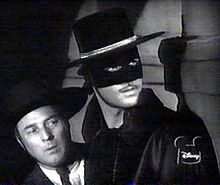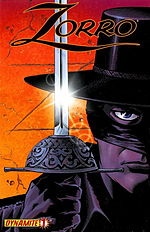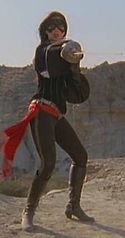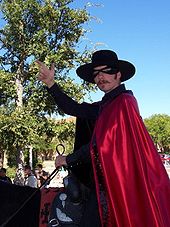- Zorro
-
For other uses, see Zorro (disambiguation).
Zorro 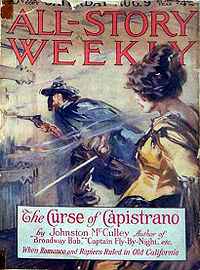
Zorro's debut:
The Curse of CapistranoPublication information Publisher Zorro Productions, Inc. First appearance All-Story Weekly vol. 100 #2 (August 6, 1919) Created by Johnston McCulley In-story information Alter ego - Don Diego (de la) Vega
(original, different successors in different versions)Abilities Superb athlete, horseman, swordsman, marksman, and unarmed combatant. Well educated, wealthy and cultured nobleman. Master of Stealth. Extensive scientific knowledge and advanced gadgets (depending on the version) Zorro (Spanish pronunciation: [ˈθoro] or [ˈsoro]) is a fictional character created in 1919 by New York-based pulp writer Johnston McCulley. The character has been featured in numerous books, films, television series, and other media.
Zorro (Spanish for fox) is the secret identity of Don Diego de la Vega (pronounced: [don ˈdjeɣo de la ˈbeɣa]; originally Don Diego Vega), a nobleman and master living in the Spanish colonial era of California. The character has undergone changes through the years, but the typical image of him is a dashing black-clad masked outlaw who defends the people of the land against tyrannical officials and other villains. Not only is he much too cunning and foxlike for the bumbling authorities to catch, but he delights in publicly humiliating those same foes.
Contents
Publishing history
Zorro (often called Señor or El Zorro in early stories) debuted in McCulley's 1919 story "The Curse of Capistrano", serialized in five parts in the pulp magazine All-Story Weekly.[1] At the denouement, Zorro's true identity is revealed to all.
Douglas Fairbanks and Mary Pickford, on their honeymoon, selected the story as the inaugural picture for their new studio, United Artists, beginning the character's cinematic tradition. The story was adapted as The Mark of Zorro (1920), a film which was a success. McCulley's story was re-released by the publisher Grosset & Dunlap under the same title, to tie in with the film.
Due to public demand fueled by the film, McCulley wrote more than 60 additional Zorro stories, beginning in 1922. The last, The Mask of Zorro (not to be confused with the 1998 film), was published posthumously in 1959. These stories ignore Zorro's public revelation of his identity. The black costume that modern audiences associate with the character stems from Fairbanks' silent film rather than McCulley's original story. McCulley's subsequent Zorro adventures copied the costume of Fairbanks's Zorro, rather than the other way around. McCulley died in 1958, just as the Disney-produced Zorro (TV series) television show was becoming popular.
Fictional history
 The Mark of Zorro, starring Douglas Fairbanks, the first Zorro film and instrumental in the early success of the character
The Mark of Zorro, starring Douglas Fairbanks, the first Zorro film and instrumental in the early success of the character
In The Curse of Capistrano Don Diego Vega becomes Señor Zorro in the pueblo of Los Angeles in California "to avenge the helpless, to punish cruel politicians", and "to aid the oppressed." He is the title character, as he is dubbed the "curse of Capistrano."
The story involves him romancing Lolita Pulido, an impoverished noblewoman. While Lolita is unimpressed with Diego, who pretends to be a passionless fop, she is attracted to the dashing Zorro. His rival and antagonist is Captain Ramon. Other characters include Sgt. Pedro Gonzales, Zorro's enemy and Diego's friend; Zorro's deaf and mute servant Bernardo; his ally Fray (Friar) Felipe; his father Don Alejandro Vega; and a group of noblemen (caballeros) who at first hunt him but are won over to his cause.
In later stories McCulley introduces characters such as pirates and Native Americans, some of whom know Zorro's identity.
In McCulley's later stories, Diego's surname became de la Vega. In fact, the writer was wildly inconsistent. The first magazine serial ended with the villain dead and Diego publicly exposed as Zorro, but in the sequel the antagonist was alive, and the next entry had the double identity still secret.
Several Zorro productions have expanded on the character's exploits. Many of the continuations feature a younger character taking up the mantle of Zorro.
Characteristics
In The Curse of Capistrano McCulley describes Diego as "unlike the other full-blooded youths of the times"; though proud as befitting his class (and seemingly uncaring about the lower classes), he shuns action, rarely wearing his sword except for fashion, and is indifferent to romance with women. This is, of course, a sham. This portrayal, with minor variations, is followed in most Zorro media.
A notable exception to this portrayal is Disney's Zorro (1957–59), where Diego, instead, appears as a passionate and compassionate crusader for justice—but masquerades as "the most inept swordsman in all of California." (Though he still adapted the more foppish persona early on to convince the then corrupted government officials that he was harmless.) In this show, everyone knows Diego would love to do what Zorro does, but thinks he does not have the skill.
Character motifs
The character's visual motif is typically a black costume with a flowing Spanish cape, a flat-brimmed black sombrero cordobés, and a black cowl sackcloth mask that covers the top of the head from eye level upwards. In his first appearance, he wears a cloak instead of a cape, and a black cloth veil mask covering his whole face with slits for eyes. Other features of the costume may vary; sometimes black riding boots or bell-bottom trousers, sometimes a vest, a waistsash or riding belt, sometimes a moustache, sometimes not.
His favored weapon is a rapier which he often uses to leave his distinctive mark, a Z made with three quick cuts. He also uses a bullwhip. In his debut, he uses a pistol.
The fox is never depicted as Zorro's emblem, but as a metaphor for the character's wiliness ("Zorro, 'the Fox', so cunning and free..." from the Disney television show theme).
His heroic pose consists of rearing on his horse, sword raised high. (The logo of Zorro Productions, Inc. uses this pose.)
Skills and resources
Zorro is an agile athlete and acrobat, using his bullwhip as a gymnastic accoutrement to swing through gaps between city roofs, and is very capable of landing from great heights and taking a fall. Although he is a master swordsman and marksman he has more than once demonstrated his prowess in unarmed combat against multiple opponents.
His calculating and precise dexterity as a tactician has enabled him to use his two main weapons, his sword and bullwhip, as an extension of his deft hand. He never uses brute strength, more his fox-like sly mind and well-practiced technique to outmatch an opponent.
In some versions, Zorro keeps a medium-sized dagger tucked in his left boot for emergencies. He has used his cape as a blind, a trip-mat and a disarming tool. Zorro's boots are also sometimes weighted, as is his hat which he has thrown, Frisbee-like, as an efficiently substantial warning to enemies. But more often than not, he uses psychological mockery to make his opponents too angry to be coordinated in combat.
Zorro is a skilled horseman. The name of his jet-black horse has varied through the years. In The Curse of Capistrano, it was unnamed. Later versions named the horse Tornado/Toronado or Tempest. In other versions, Zorro rides a white horse named Phantom.
McCulley's concept of a band of men helping Zorro is often absent from other versions of the character. An exception is Zorro's Fighting Legion (1939), starring Reed Hadley as Diego. In McCulley's stories, Zorro was aided by a deaf mute named Bernardo. In Disney's Zorro television series, Bernardo is not deaf but pretends to be, and serves as Zorro's spy. He is a capable and invaluable helper for Zorro, sometimes wearing the mask to reinforce his master's charade. The Family Channel's Zorro television series replaces Bernardo with a teenager named Felipe, played by Juan Diego Botto, with a similar disability (his muteness is the result of trauma) and pretense.
Inspirations
Zorro bears some similarities to historical Andalusian bandits of the 18th and 19th centuries.[citation needed] He is most closely associated with Joaquin Murrieta, whose life was fictionalized in an 1854 dime novel by John Rollin Ridge. Other possible inspirations for the character include Robin Hood, Reynard the Fox, Salomon Pico, Manuel Rodríguez Erdoíza, and Tiburcio Vasquez. Another possibility was William Lamport, an Irish soldier living in Mexico in the 17th century. His life inspired a fictional book by Vicente Riva Palacio, and a biography, The Irish Zorro, was published in 2004. The Yokuts Indian Estanislao, who led a revolt against the Mission San Jose in 1827, is another possible inspiration. In the 1998 film The Mask of Zorro, Murrieta's (fictional) brother succeeds Diego as Zorro.
The 1890s penny dreadful treatment of the Spring Heeled Jack character as a masked avenger may have inspired some aspects of Zorro's heroic persona. Spring Heeled Jack was portrayed as a nobleman who created a flamboyant, masked alter ego to fight injustice, frequently demonstrated exceptional athletic and combative skills, maintained a hidden lair and was known to carve the letter "S" into walls with his rapier as a calling card.
Like the Scarlet Pimpernel, Zorro keeps his true identity free of suspicion by acting as a fop or dandy in his persona as the nobleman Don Diego. The all-black Fairbanks film costume, which with variations has remained the standard costume for the character, was likely adapted from that of the Arrow film serial character The Masked Rider. In 1919, he was the first Mexican black-clad masked mystery rider on a black horse to be seen on the silver screen, before the following year's release of The Mark of Zorro. Fairbanks' costume is identical to the Rider's, albeit with a half-mask and without the hat.
Appearances in media
Books
- Johnston McCulley's original magazine serial, "The Curse of Capistrano" from All-Story Weekly, was published in 1924 as a novella by Grosset & Dunlap under the title The Mark of Zorro. It was reprinted by MacDonald & Co. in 1959 and by Tor books in 1998, ISBN 978-0-8125-4007-9.
- Johnston McCulley's Zorro short stories were reprinted by Pulp Adventures Inc. in a series of trade paperback editions.
- Zorro The Master's Edition Volume One (1932–1944) February 2000 ISBN 1891729209
- Zorro The Master's Edition Volume Two (1944–1946) January 2002 ISBN 1891729217
- Zorro The Master's Edition: A Task For Zorro (1947) July 2002 ISBN 1891729314
- A series of paperback novels were published by Tom Doherty Associates, Inc. Books in the late 1990s and early 2000s.
- Zorro and the Jaguar Warriors by Jerome Preisler September 1998 ISBN 978-0-8125-6767-0
- Zorro and The Dragon Riders by David Bergantino March 1999 ISBN 978-0-8125-6768-7
- Zorro and the Witch's Curse by John Whitman April 2000 ISBN 978-0-8125-6769-4
- Gerard Ronan's Biography of William Lamport "The Irish Zorro" was published by Brandon Books in 2004. ISBN 978-0863223297.
- Minstrel Books published A series of young reader novels based on the motion picture The Mask of Zorro.
- The Treasure of Don Diego by William McCay 1998 ISBN 978-0-671-51968-1
- Skull and Crossbones by Frank Lauria 1999 ISBN 978-0-671-51970-4
- The Secret Swordsman by William McCay 1999 ISBN 978-0-671-51969-8
- The Lost Temple by Frank Lauria 1999
- Zorro filmographic books have also been published:
- The Legend of Zorro by Bill Yenne 1991 Mallard Press ISBN 978-0-7924-5547-9
- Zorro Unmasked The Official History by Sandra Curtis 1998 Hyperion ISBN 978-0-7868-8285-4
- Tales of Zorro anthology edited by Richard Dean Starr 2008 Moonstone Books ISBN 978-1-933076-31-7
- The character was also the subject of a historical novel by a famous Chilean author.
- Zorro by Isabel Allende 2005 HarperCollins ISBN 0-06-077897-0 (see article)
Films
The character has been adapted for over forty films.[2] They include:
- The Mark of Zorro (1920), with Douglas Fairbanks
- Don Q, Son of Zorro (1925), with Douglas Fairbanks
- The Bold Caballero (1936), with Robert Livingston
- Zorro's Fighting Legion (1939), with Reed Hadley
- The Mark of Zorro (1940), with Tyrone Power
- The Sign of Zorro (1958), with Guy Williams, portions of the first 13 Zorro TV series episodes edited into a feature film, released overseas in 1958 and domestically in 1960.
- Zorro, the Avenger (1959), with Guy Williams, another theatrical compilation of several Zorro TV episodes, released overseas, and was not seen in the United States until it was eventually aired on the Disney Channel.
- Zorro (1961) and The Shadow of Zorro (aka Zorro the Avenger) (1962), two Spanish features starring Frank Latimore.[3]
- La Gran Aventura Del Zorro (1974), Mexican Western with Rodolfo de Anda, the first Mexican actor to play the role; with Pedro Armendáriz Jr. as the villain and set in a very primitive San Francisco Bay Area.
- Zorro (1975), Zorro meets the spaghetti western, with French actor Alain Delon as Diego Vega, posing as Governor Miguel de la Serna (a slain friend) of Nuova Aragon, fighting the corrupt Colonel Huerta.
- Zorro, The Gay Blade (1981), a parody, with George Hamilton. Diego, Jr., breaks his leg shortly after launching his career as a new Zorro, and his gay twin brother Ramon, now calling himself Bunny Wigglesworth, volunteers to fill in while he recuperates.
- The Mask of Zorro (1998), played against tradition, with Anthony Hopkins as an aged Diego de la Vega and Antonio Banderas as Alejandro Murrieta, a misfit outlaw who is groomed to become the next Zorro (making Banderas the first Spanish actor to play the character).
- The Legend of Zorro (2005), the sequel to the 1998 The Mask of Zorro, again starring Antonio Banderas.
Film serials
- Zorro Rides Again (1937), with John Carroll as a modern-day descendant, James Vega
- Zorro's Fighting Legion (1939), with Reed Hadley
- Zorro's Black Whip (1944), with Linda Stirling as an 1880s female descendent, The Black Whip
- Son of Zorro (1947), with George Turner
- Ghost of Zorro (1949), with Clayton Moore
Television
- Zorro, a Walt Disney-produced half-hour television series, running from 1957 to 1959, and starring Guy Williams as Zorro. The two Guy Williams-starred features above were episode compilations, and there were two one-hour follow-ups on the Walt Disney anthology television series in the 1959–1960 TV season.
- The Mark of Zorro (1974), with Frank Langella, a made for television remake of the 1940 film
- The New Adventures of Zorro, 1981 animated series from Filmation.
- Zorro and Son, 1983
- Zorro (also known as The New Zorro or New World Zorro or Zorro 1990) was an early 1990s television series featuring Duncan Regehr. Regehr portrayed him for 88 episodes on The Family Channel from 1990 to 1993. Two feature length videos were episode compilations. It was shot entirely in Madrid, Spain.
- Kaiketsu Zorro (1996) Japanese anime version from NHK and Ashi Productions.
- The New Adventures of Zorro, 1997 animated series from Warner Bros..
- The Amazing Zorro, 2002 made for TV animated film created by DIC Entertainment. It premiered on television on Nickelodeon Sunday Movie Toons and was released on DVD and VHS shortly afterward by MGM Home Entertainment.
- Zorro: La Espada y la Rosa (The Sword and the Rose), a (2007) Spanish language telenovela from Sony Pictures and Telemundo, starring Peruvian actor Christian Meier as Don Diego de la Vega/Zorro and Marlene Favela as Esmeralda Sánchez de Moncada. This was filmed in the colonial village of Villa de Leyva, Colombia.
- Zorro: Generation Z,[4](2008) animated series follows a descendant of the original Zorro, also named Diego De La Vega, fighting crime and the corrupt government of Pueblo Grande in a future setting.
- Zorro, a 2009 TV series from the GMA Network of the Philippines is local remake of the novel. The lead role is portrayed by Richard Gutierrez[5] with leading ladies Rhian Ramos, Bianca King, and Michelle Madrigal.
Audio/Radio Dramas
- Disney Zorro: [1. Presenting Señor Zorro; 2. Zorro Frees The Indians; 3. Zorro And The Ghost; 4. Zorro's Daring Rescue] (1957) released by Disneyland Records/ Buena Vista Records release. These albums retold stories from the Disney Zorro television series and featured Guy Williams as Zorro and Don Diego, Henry Calvin as Sergeant Garcia, Phil Ross as Monastario, Jan Arvan as Torres, Jimmie Dodd from The Mickey Mouse Club as Padre Felipe, with other voices by Dallas McKennon and sound effects by Jimmy Macdonald and Eddie Forrest. Record story adaptations by Bob Thomas and George Sherman. Music composed and conducted by William Lava.
- The Adventures of Zorro. (1957) Based on the original Johnston McCulley story The Curse of Capistrano (aka The Mark of Zorro). It was written by Maria Little, directed by Robert M. Light and produced by Mitchell Gertz. This short-lived radio show was a series of short episodes. Only a handful of episodes are known to have survived.
- The Mark of Zorro. (1997) [No longer available] Produced by the BBC it starred Mark Arden as Zorro, Louise Lombard as Lolita and Glyn Houston as Friar Felipe. It aired in 5 parts. 1. July 3 97 Night of the Fox: 2. July 10 97 Deadly Reckonings: 3. July 17 97 The Avenging Blade 4. July 24 97 The Place of Skulls 5. July 31 97 The Gathering Storm
- Zorro and the Pirate Raiders. (2009) Based on the D.J. Arneson adaptation of Johnston McCulley's The Further Adventures of Zorro. Produced by Colonial Radio Theatre on the Air. Published by Brilliance Audio. It features Kevin Cirone, Shonna McEachern, Hugh Metzler, J.T. Turner, Sam Donato, Joseph Zamperelli Jr., and Dan Powell.
- Zorro Rides Again. (2011) Based on the D.J. Arneson adaptation of Johnston McCulley's Zorro Rides Again. Produced by Colonial Theatre on the Air. It features the voice talents of Kevin Cirone, Jeremy Benson, Shonna McEachern, Shana Dirk, Sam Donato, and Hugh Metzler.
- The Mark of Zorro. (2011) The action adventure story that inspired a legend. Based on the original Johnston McCulley Zorro story The Curse of Capistrano (aka The Mark of Zorro). Produced by Hollywood Theater of the Ear for Blackstone Audio. Written and directed and co-produced by the multi-award winning Yuri Rasovsky. Executive Producers: John Gertz of Zorro Productions and Josh Stanton of Blackstone Audio. Associate Producer Daryl McCullough. It features the voice talents of Val Kilmer as Diego de la Vega/Zorro, Ruth Livier as Lolita Pulido, Elizabeth Peña as Doña Catalina Pulido, Armin Shimmerman as the Landlord, Mishach Taylor as Sgt Pedro Gonzalez, Keith Szarabajka as Cpt Ramone, Ned Schmidtke as Don Carlos Pulido, Scott Brick as the Governor, Stefan Rudnicki as Fray Felipe, Kristoffer Tabori as Don Alejando de la Vega, Philip Proctor as Don Audre, John Sloan as the Magistrado, and Gordo Panza in numerous roles.
Toys
In 1958, The Topps Company produced an 88 card set featuring stills from that year's movie. The cards were rare and became collectors' items.
A major toy line based on the classic Zorro characters, motifs and styling, was released by Italian toy giant, Giochi Preziosi, master toy licensees of the property. The toy range was developed by Pangea Corporation and released worldwide in 2005 and featured action figures in various scales, interactive playsets and roleplaying items. New original characters were also introduced, including Senor Muerte, who served as a foil to Zorro.
In 2007, Brazilian toymaker Gulliver Toys licensed the rights to Zorro: Generation Z, which was co-developed by BKN and Pangea Corporation. The toy range was designed concurrent and in association with the animated program.
Comics
Zorro has appeared in many different comic book series over the decades. One version was rendered by Alex Toth for Dell Comics in Four Color magazine starting in 1949 and appearing through the 1950s. Zorro was given his own title in 1959, which lasted 7 more issues and then was made a regular feature of Walt Disney's Comics and Stories (also published by Dell) from #275 to #278. Gold Key Comics began a Zorro series in 1966, but, like their contemporaneous Lone Ranger series, it featured only material reprinted from the earlier Dell comics, and folded after 9 issues, in 1968. The character remained dormant for the next twenty years until it was revived by Marvel Comics in 1990, for a 12-issue tie-in with the Duncan Regehr television series Zorro. Many of these comics had Alex Toth covers.
Over the years, various English reprint volumes have been published. This include but are not limited to:
- Zorro In Old California Eclipse Books ISBN 978-0-913035-12-2
- Zorro The Complete Classic Adventures By Alex Toth. Volume One Image Comics 1998. ISBN 978-1-58240-014-3
- Zorro The Dailies - The First Year By Don McGregor, Thomas Yeates. Image Comics 2001. ISBN 1582402396
In 1993 Topps Comics published a 2-issue mini-series Dracula Versus Zorro followed by a Zorro series that ran 11 issues. Topps created Lady Rawhide, a spin-off from the Zorro stories, in two brief series. All of this was written by Don McGregor. He subsequently scripted a miniseries adaptation of The Mask of Zorro film for Dark Horse Comics.
A newspaper daily and Sunday strip were also published in the late 1990s. This was written by McGregor and rendered by Tom Yeates. Papercutz once published a Zorro series and graphic novels as well. This version is drawn in a manga style.
Dynamite Entertainment relaunched the character in 2008 with writer Matt Wagner first adapting Isabel Allende's novel before writing his own stories. The publisher also released an earlier unpublished tale by Don McGregor.
The character also appeared in European comics and is universally beloved in Latin America, usually in licensed, translated reprints of American comics. In the Netherlands, Zorro was drawn by Hans G. Kresse for the weekly Pep.
Stage productions
A musical titled Zorro opened in the West End in 2008. It is directed by Christopher Renshaw, choreographed by Rafael Amargo and features music from the band Gipsy Kings. Directed by Christopher Renshaw, Zorro features the choreography of flamenco dancer Rafael Amargo.
Music
On the commercial release of the Disney series' Zorro theme, the lead vocal was by Henry Calvin, the actor who played Sergeant Garcia on the program.
Henri Salvador had a hit[citation needed] in 1964 with the humorous song "Zorro est arrivé." It tells from a child's point of view how exciting it is whenever a villain threatens to kill a lady in the television series. But every time again, to his relief, the "great and beautiful" Zorro comes to the rescue. An early music video was made at the time.
Alice Cooper's 1982 album Zipper Catches Skin includes the song "Zorro's Ascent" which is about Zorro facing his death.
Computer and video games
- Zorro (Sinclair ZX Spectrum computer game)[6]
- The Mask of Zorro (1999), Game Boy Color
- The Shadow of Zorro (2001), PC, PlayStation 2
- The Destiny of Zorro, announced in 2008 for Wii
- Zorro: Quest for Justice (20**), Nintendo DS
- There is a Zorro themed poker machine available to play at most gaming establishments in Australia and New Zealand
Copyright and trademark
Tessie Santiago as The Queen of Swords
The copyright and trademark status of the Zorro character and stories has been disputed.
A company called Zorro Productions, Inc., asserts that it "controls the worldwide trademarks and copyrights in the name, visual likeness and the character of Zorro."[7] It further states that "The unauthorized, unlicensed use of the name, character and/or likeness of 'Zorro' is an infringement and a violation of state and federal laws."[8]
These claims were disputed in the case Sony Pictures Entertainment v. Fireworks Ent. Group.[9] On January 24, 2001, Sony Pictures, TriStar Pictures and Zorro Productions, Inc. sued Fireworks Entertainment, Paramount Pictures, and Mercury Entertainment, claiming that the Queen of Swords television series infringed upon the copyrights and trademarks of Zorro and associated characters. Sony and TriStar had paid licensing fees to Zorro Productions, Inc., related to the 1998 film The Mask of Zorro. Queen of Swords was a 2000–2001 television series set in Spanish California during the early 19th century and featuring a protagonist who wore a black costume with a red sash demonstrating many aspects of the Zorro character including the swordfighting skills of the rapier and dagger, the dagger in the boot, use of a whip and Bolas, and horse riding skills.
Zorro Productions, Inc., argued that it owned the copyright to the original character because Johnston McCulley assigned his Zorro rights to Mitchell Gertz in 1949. Gertz died in 1961 and his estate transferred to his children, who created Zorro Productions, Inc. Fireworks Entertainment argued that the original rights had already been transferred to Douglas Fairbanks, Sr. in 1920 and provided documents showing this was legally affirmed in 1929, and also questioned whether the copyright was still valid.
The court ruled that "since the copyrights in The Curse of Capistrano and The Mark of Zorro lapsed in 1995 or before, the character Zorro has been in the public domain".[10]
Judge Collins also stated that: "Plaintiffs' argument that they have a trademark in Zorro because they licensed others to use Zorro, however, is specious. It assumes that ZPI had the right to demand licenses to use Zorro at all."
On March 22, 2010, Zorro Productions, Inc., sued Mars, Incorporated, makers of M&M's chocolate candies, and ad agency BBDO Worldwide over a commercial featuring a Zorro-like costume.[11] The case was dismissed with each party covering their own costs on August 13, 2010.[12]
Popular culture
- Bob Kane has credited Zorro as part of the inspiration for the Batman.[13] Like Zorro, Bruce Wayne is affluent, the heir of wealth built by his parents. His everyday persona encourages others to think of him as shallow, foolish and uncaring to throw off suspicion. Frank Miller's The Dark Knight Returns and The Dark Knight Strikes Again includes multiple Zorro references including the Batman inscribing a Z on a defeated foe.
- Zorro's black mask, cape and gaucho hat have been adopted by mascots at University of California Santa Barbara (Gauchos), University of San Francisco, Texas Tech University and Edward S. Marcus High School.
- Puss in Boots, the cat in the Shrek film series, was based both on the fairy tale character of the same name and on Zorro. The character was voiced by Antonio Banderas, the actor who portrayed Zorro in The Mask of Zorro and The Legend of Zorro. At one point the cat uses his sword to scratch a "P" on his victime, a parody of Zorro's trademark move.
References
- ^ All-Story Weekly vol. 100 #2, August 9, 1919, 101:2, September 6, 1919
- ^ Zorro Productions, Inc.
- ^ Maltin, Leonard, Leonard Maltin's Movie Guide 2007 Edition, Plume, 2006, pp. 1519 & 1181.
- ^ Zorro: Generation Z
- ^ Zorro Conquers the Philippines
- ^ Zorro (Sinclair ZX Spectrum computer game)
- ^ "About Zorro Productions Inc." page from the company's web site
- ^ "Highlights of the Zorro Publishing Program" page from the company's web site.
- ^ "Sony Pictures Entertainment v. Fireworks Ent. Group." at Google Scholar, retrieved Dec. 4, 2010.
- ^ Note 31 of Sony Pictures Entertainment v. Fireworks Ent. Group.
- ^ Zorro complaint
- ^ [1]|Zorro Productions v Mars Inc. and BBDO worldwide
- ^ Boichel, Bill. "Batman: Commodity as Myth." The Many Lives of the Batman: Critical Approaches to a Superhero and His Media. Routledge: London, 1991. ISBN 0-85170-276-7, pg. 6–7
External links
- Zorro Productions, Inc.
- A comprehensive guide to the New World Zorro television series
- Zorro The Musical 2008
- A guide to the Walt Disney television series version of Zorro
- Zorro at the Internet Movie Database
Zorro Books Films The Mark of Zorro (1920) · Don Q, Son of Zorro · The Bold Caballero · Zorro Rides Again · Zorro's Fighting Legion · The Mark of Zorro (1940) · Zorro's Black Whip · Son of Zorro · Ghost of Zorro · La gran aventura del Zorro · The Mark of Zorro · Zorro · Zorro, The Gay Blade · The Mask of Zorro · The Legend of ZorroTelevision Zorro (1957) · The New Adventures of Zorro (1981) · Zorro and Son · Zorro (1990) · Kaiketsu Zorro · The New Adventures of Zorro (1997) · Zorro: La Espada y la Rosa · Zorro: Generation Z · Zorro (2009)Stage productions Video games Categories:- Media franchises
- Series of books
- Fictional characters from California
- Fictional American people of Spanish descent
- Fictional vigilantes
- Characters in pulp fiction
- Film serial characters
- Western (genre) characters
- Zorro
- Fictional sword fighters
- Fictional gentleman thieves
- Fictional outlaws
- 1919 introductions
Wikimedia Foundation. 2010.

